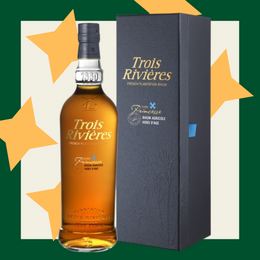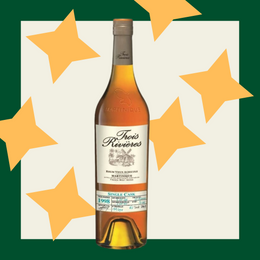
Coming from the Carrère distillery located in Petit-Bourg in Guadeloupe, the 1948 vintage has, like many very old vintages, a rather vague history. The most reliable sources report a rum that was present at the purchase of the distillery and that draws its source from another estate. Of course, these are only suppositions and in the absence of concrete proof, we would have to believe, or at least trust, the polished and often charming speech of the seller sites. This would mean that it would then be a rum that had aged more than 42 years, distilled in 1948 and bottled in March 1990 in two versions: a first at 47° in a sandblasted glass bottle with a capacity of 70cl, and a second at 55° in a 75cl bottle (classic and transparent glass).
Rumors and concrete
Rumors have been flying since these two versions came into existence and some have even sometimes spoken of counterfeiting, but the distillery has never denied it or even given a clear explanation about this vintage and the rumors surrounding it. Let us remember that many bottles and stories died out at the same time as the former owners and that safeguarding information was never a priority at the time, nor even easy to implement, as time generally and insidiously erases the few fragments that have managed to pass through the generations. Some still like to deliberately maintain the confusion, for their image (glory?) or to justify high prices. In any case, the bottle is not the one usually used at the distillery, and it could therefore be an external bottling (via a group or other, and not necessarily on site).
More concretely and based on the history of the distillery through different works, let us recall that the Carrère distillery was founded in 1930 then closed in 60 before being bought in 1968 by Jean Marsolle who gave it a second wind. Did the stock of this 1948 vintage then date from the old era of the distillery, or would it come from stocks of colleagues as some sources affirm?

If we look at volume 3 of the encyclopedia coordinated by Alain Grillon-Schneider published in 1987 ( Cane, sugar and rum in the French Antilles and Guiana from the 17th to the 20th century ), it is stated that Montebello put its rum to age "for the first time in 1983 " , a year during which "120,000 liters at 50° were stored for aging. This is a blended rum (half agricultural, half industrial) at 50° and an amber rum at 40°, made from molasses from sugar factories" . Note that there is also a 1982 vintage in the same type of bottle, but also a more 'official' 1982 presented in the usual glassware .
Regarding the age of the rum from the 1948 vintage, we can wonder about what is announced, namely "more than 42 years", especially since the label of the 55° version mentions " kept in the same oak cask since 1948 ". But a cask of what capacity exactly? Let us recall that a cask is a large wooden vat of very large capacity that can contain several dozen hectoliters, sometimes up to several certain ones, thus equivalent to several barrels. Can we then speak of aging for 42 years? Technically, and especially legally, the cask in question must be 650 liters maximum as stipulated in the decree of July 25, 1963 , consolidated in 1993 and 1999:

Not to mention that 42 years of aging must have really satisfied the angels and caused a huge evaporation. If we start from the maximum capacity authorized for aging in oak casks (650 liters therefore), and counting on average a share of angels/annual evaporation of 8%, there would potentially be 20 liters of rum left at the bottom of the cask after 40 years. ( read the article Myth or Reality to go further )
Several hypotheses:
– the passage in the tuns was counted in the aging time, which is not correct (but which would not be new) nor legal given the bottling date of the rum (March 90) and the decree of 1963.
– the evaporation was limited voluntarily (for example by varnishing the outside of the tuns, it is possible to almost limit the evaporation by 2) which is not authorized, precisely because of the influence on the angels' share.
– there was not 1 but several tuns of this rum and the label would then be incorrect.
The version of the 1948 vintage marketed at 55 ° speaks of " resting for more than 40 years in oak barrels, barrels that previously contained Armagnac" . The notion of "resting" and not "aging" is certainly thin but of significant importance, because it clearly goes in the direction of the use of larger capacity tuns (and not aging in barrels). The bottling date is the same as the other version of the vintage (March 90) and the rum could just as well come from the same tuns but this time offered in a brut de fût version (or moderately diluted). In any case, the evaporation share would remain at 8% and the quantity of rum remaining after 40 years very low... the mystery remains, but it seems conceivable to say that this rum, finally these rums, are certainly not that old.
From one 1948 vintage to another
There is another vintage from 1948 which is quite present in the rum world, also coming from Guadeloupe: the Domaine de Courcelles 1948.
"a rum that has been aged in oak barrels for over 20 years and then kept in a huge oak tuns" until it was marketed. A rum " produced by distilling the juice of sugar cane from the sunny plains of Guadeloupe, from the south of Grande Terre to be precise. " With here too several official bottlings (with opaque and transparent bottles) and even 'external' bottlings from independent bottlers/merchants (rum house, velier, etc.) which easily suggest quite substantial stocks. So happy coincidence or chance? The profile of Courcelles and Montebello being fundamentally different, let's lean towards chance, and focus more particularly on the 2 vintages from the Carrère distillery...

Montebello 1948 / 47°
Distilled and put in barrels in 1948, this rum presented in a 70cl bottle would have spent more than 40 years in oak barrels, barrels that had previously contained Armagnac. Bottled in March 90, there is also a 1982 vintage (45°) presented in the same type of bottle (and with the same label).
The color of this rum is a fairly strong amber, tending towards a shiny bronze and which draws luscious legs.
The nose delivers toasted notes, brown/burnt sugar and walnut husk, nicely highlighted by a black confit (prune) and an imposing liquorice which fully develops; black and classy, the rum oscillates on a chocolate marzipan and even makes the earth speak. With rest, the rum seems to settle down, become more gourmet and now goes on a fruity end of life (exit the prune and hello the exoticism: papaya, peach, caramelized apricot) and almost mentholated.
There is also in this Montebello 1948 a very classy phenolic side, and not without recalling common markers with other rums of the house (including the excellent 6 years). A little more time and the kinship with the Armagnac cask (Cognac itself) becomes more striking.
On the palate, the attack is oily and concentrates crescendo, delivering the richness that was expected on the nose: licorice, spices, burnt sugar and some smoky, briny, iodized notes (black olive) that intelligently awaken the taste buds and blend harmoniously with the old tannins. The rum is dry on the palate, but does not forget to be delicate with a fruitiness that oscillates between fruits in brandy (prune) and dried fruits with a tangy exoticism (citrus, orange) and caramelized (apricot). The finish is executed delicately, on licorice and dried fruits, gently, and revived by the iodized side that plunges us back into dreams. Definitely old with this aura of another era, reassuring.
Very nice rum, which is certainly not 40 years old (and that is rather very good news), very rich and interesting on the palate, with that inimitable little something old. Another time, another rum. Rating: 89
-------------------------------------------------------------------------------------------------------------

Montebello 1948 / 55°
Same vintage, same bottling date, but different version. This time the rum is offered in a transparent 75 cl bottle and at 55°. The sales pitch speaks of an aging of more than 42 years and a bottling in March 1990. "A rum selected by Mr A. Marsolle of the Domaine de Montebello" and also " kept in the same oak cask since 1948" . We no longer speak of ex-Armagnac casks either.
The color here is also on a sustained amber, bronze, but with a greenish effect, almost chocolatey. Much oilier than its little brother and also much better mounted given the multitude of legs, serious and fat.
On the nose, the rum is its degree and ruffles (unlike the one at 47° which was not really its degree). With a little hindsight, we have more rotten fruits, more heavy and fermented notes, olive, earth and our faithful liquorice. We are even closer to a rum of the profile of Montebello and especially from Bellevue, with phenolic, tarry and briny notes as desired.
More of everything and especially more heaviness, with a black liquorice (zan candy) and a sweetness that flatters the audience; a little more rest will even tend to chocolate it. The liquorice is still there, black as coal, prune, burnt spices with caramel and a woodiness that is not so present; and more chocolate and a little more gourmandise.
The attack is powerful and concentrated, saline with olives and liquorice, and a fruity candied in an XXL compote that explodes in your mouth. Almost medicinal even, resinous and necessarily rich and full of heavy, phenolic and briny aromas. The iodized side once again has its effect in the mouth, increases the sensations tenfold and exhausts the notes of the rum with olives stuffed with liquorice left to ferment in a mixture of oil and mint in which macerated black fruits have been added; in the mode of a spearmint tapenade and its cup of candied fruits. The finish is powerful (alcohol), fresh (iodized/icy mint) and heavy (licorice) with the return of dried fruits (prune). Great aromatic persistence and superb impression.
In the line of the Montebello 1948 at 47° but with necessarily more power. We will lose delicacy and gourmandise in the process, but we will gain wildness and an extra black olive… In the end it is extremely rare (if not unique) to come across such an old vintage and offered at such a high degree, and the result is exceptional; there is something for everyone. So power or balance? the choice is not easy… for me it will be power. Score: 92
To help you (and me) find your way around, regarding the notes:
90 and + : exceptional and unique rum, it is the best of the best
between 85 and 89 : highly recommended rum, with that little something that makes the difference
between 80 and 84 : recommendable rum
75-79 POINTS : above average
70-74 POINTS : in the low average
less than 70 : not very good
Review courtesy of DuRhum.com.
From the folks behind DuRhum, Velier, and more, comes a premium online marketplace for rum enthusiasts by rum enthusiasts! Do check out www.rowspirits.fr for more great content and iconic rums!








